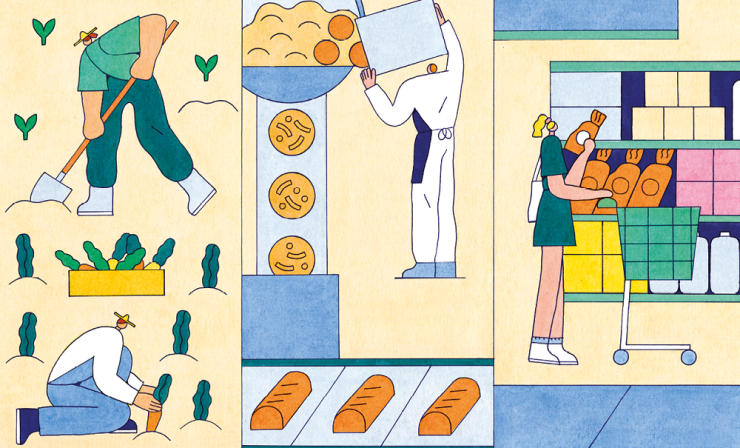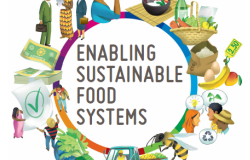Ressources dossier
Food, Global HealthPromoting a global dynamic of agricultural and food systems: examples
Published on 18 January 2023
1. Developing efficient and environmentally friendly agricultural practices

To develop efficient and environmentally friendly agricultural practices, we have to assess the potential of the land that is available, and for what use.
In 2020, INRAE and CIRAD presented the results of the GloFoodS programme “Transitions for Global Food Security”, which financed 45 research projects, mobilising more than 200 researchers over 8 years in France and abroad, particularly in French-speaking Africa and South-East Asia. The work contributed to a better understanding of variations in crop and animal production yields, to assessing on a global scale the potential of land available for food, energy and bio-industrial purposes, to identifying processes and organisations that limit losses and waste, as well as to providing information on the links between household access to food and social inequalities. Among the objectives: to propose more efficient and environmentally friendly production systems and practices and to limit losses and waste. These two aspects of transition rely on innovations in the organisation of food value chains, for better access to healthy and sufficient food, by means of agri-food processes that are more economical with agricultural resources.
For example, the GloFoodS “Legend” project studied the adaptation of agriculture to urbanisation in a case study in Madagascar. The results showed that urban and peri-urban agriculture plays a key role in food security: it supplies the capital with fresh produce and covers almost all the needs of its population for eggs and poultry, as well as a large part of its vegetable needs. Agriculture does not inevitably succumb in the face of urban sprawl; it is maintained and developed, thanks to farmers who adapt their production systems by introducing new crops and using agro-ecological approaches.
Another example of mobilising the lever of system change: the GloFoodS “Serena” project aimed to explore the potential benefits of agroforestry parks on food security and livelihoods of rural households in the groundnut basin of Senegal, through the diversity of agricultural landscapes. Using remote sensing data, modelling and statistical methods, the study showed the benefits of trees for crop productivity, but only up to a certain point: namely, when the tree starts competing with the crop. It thus appeared that trees cannot directly strengthen the coping strategies of food-insecure households, but contribute to the improvement of the production system.
2. Creating resilient and solidarity- based food systems
By building solutions at all levels, international, national and local, it is possible to create resilient and solidarity-based food systems.
One of the keys: increasing producer-consumer interactions.
Because there is no one-size-fits-all solution, INRAE has partnered with the FAO to study numerous initiatives around the world that aim to produce, share, sell and consume more sustainable food. The study, led by sociologist Allison Marie Loconto, Deputy Director of INRAE’s Interdisciplinary Laboratory for Science, Innovation and Society (LISIS), shows that the resilience of food systems depends in particular on innovations for the relocation and diversification of food systems. Incentives can help prioritise access to beneficial foods for vulnerable communities, promote sustainable agriculture, including the protection of biodiversity, and encourage healthy and nutritious diets.
Examples include the creation of social networks in Finland to facilitate communication between producers and consumers, the development in France of “field schools” for producers or “incubator farms” so that producers can test new practices without economic risk, as well as the implementation of a plan in Brazil to collect organic waste at 900 weekly markets for compost.
Bringing producers and consumers closer together
The fundamental outcome of these initiatives is to increase the interactions between producers and consumers, and to change the way they influence and interact within their food environment.
This study was the subject of a book designed as a manual for actors who wish to innovate in the food systems they are involved in. These types of local food systems have demonstrated their resilience during the COVID-19 crisis in Africa, India or Brazil. They all use sustainable farming practices based on the 10 elements of agroecology producing food for local and regional markets, thus ensuring food security and access to healthy and affordable food for the disadvantaged population and the middle class.

Drawing on seven years of collaborative research and action with multiple innovators from more than 20 countries across Africa, Asia, Europe and Latin America, their experiences and advice have been collected in an Innovator’s Handbook entitled Enabling Sustainable Food Systems. Find out resourceful tips, tricks of trade and advice on how to innovate for sustainable food systems.
3. Stopping food waste along the chain
In Europe, 1 in 5 foods is lost or wasted, or 173 kg per person each year.
In Europe, 1 in 5 foods is lost or wasted, or 173 kg per person each year. Generally speaking, in developed countries 2/3 of food waste occurs at the consumer end, with the rest being lost along the production chain. “In developing countries, poverty effectively causes consumers not to waste. Instead, losses occur at the harvest, transport and storage stages. Difficult weather conditions, plant diseases, inadequate equipment and poor roads are all factors. In Africa and South-East Asia, post-harvest losses in cereals account for up to 20% of production”, explains Barbara Redlingshöfer, an INRAE engineer at the SADAPT (Science for Action and Development: Activities, Products, Territories) joint research unit. Her work proposes combining different solutions to reduce food losses.
On the one hand, genetically improving varieties to make them resistant to disease, optimising harvesting equipment and better organising the supply chain. On the other hand, lowering consumer expectations regarding the appearance of products, particularly fruit and vegetables.
-
Élodie Regnier / Anaïs Bozino
(Send email)
Authors / translated by Alessandra Riva
Communications Department
